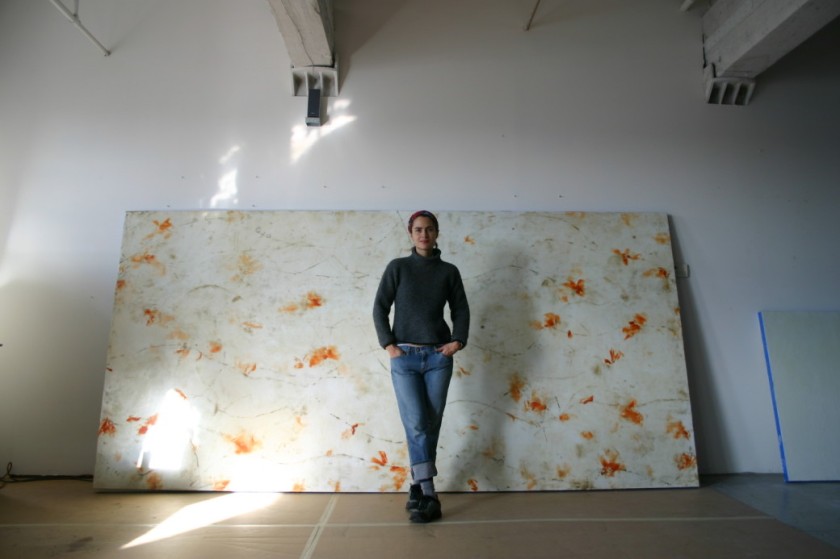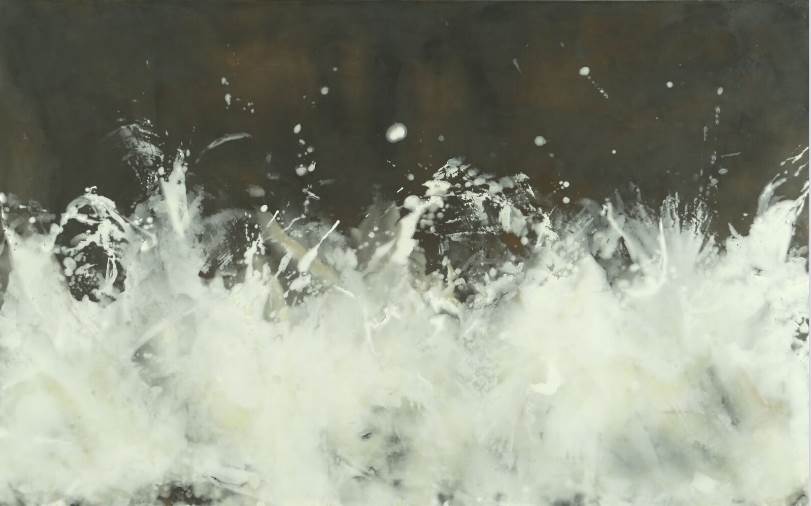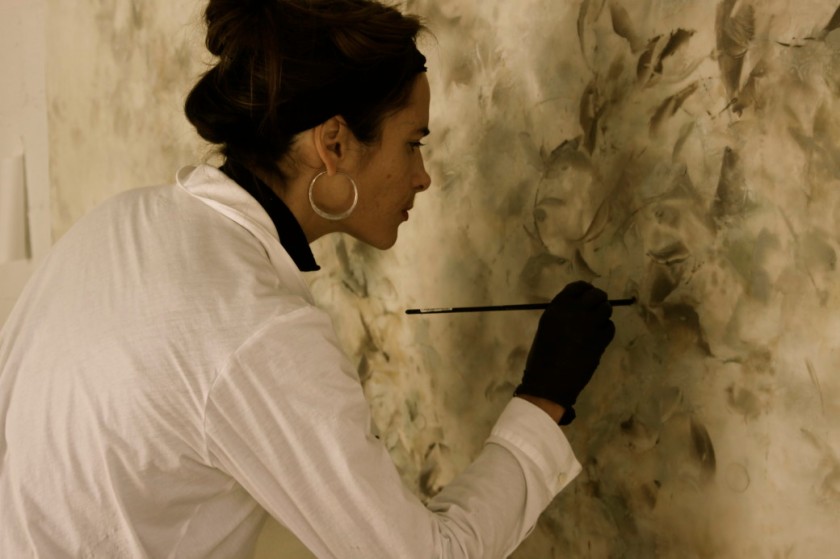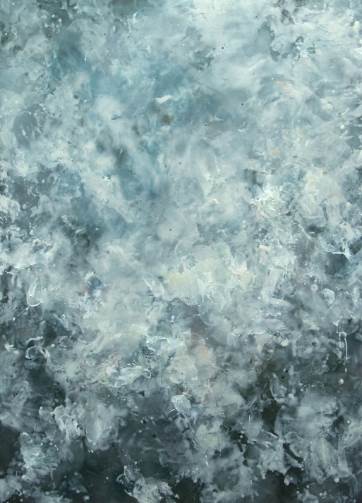Painting is silent poetry with Betsy Eby
written by alixdeboisset
In her paintings, Betsy Eby fuses the line between the musical and the visual composition. A classically trained pianist, she seeks in her work what Rothko described as “the place where music lives.” The layers and gestures of her paintings evoke musical spaces and rhythms while drawing on patterns found in nature. From her early childhood, musical and natural rhythms blended in Eby’s sensibility. She spent her first years of life in a small town on the Oregon coast, practicing at the family piano by the age of five. Today her work reveals that interconnected sensitivity: her delicate, organic compositions become synesthesias of sound and image.
Painting with Fire features the artist’s recent paintings that utilize the technique of encaustic, which means “to burn.” The process is an ancient one by which layers of pigments, sap, and wax are fused together by the flame of a torch. Eby has slowly refined the technique to her own language, composing dynamic surfaces and deep, luminous spaces. Her abstract paintings incorporate a soothing palette and subtly reference wildflowers, flowing water, migratory birds, frost covered leaves, and misty forests. By employing beeswax in her painting process, she slowly builds up the surfaces of her canvases, creating depth and texture that heighten the organic quality of her work. Her paintings are visceral, yet for Eby they shimmer with something more of the mystical, hovering between material and immaterial worlds as do the worlds of sight and sound.
Betsy Eby received her BA from the University of Oregon. She and her husband, painter Bo Bartlett, split their time between studios in Columbus, Georgia, and Wheaton Island, Maine. She savors the spaciousness and light of both of these studios, and her paintings evoke the atmosphere of the vast ocean that surrounds her small island residence in Maine. Her work has been shown and collected by the Georgia Museum of Art and the Columbus Museum, and she has shown frequently with Winston Wachter Fine Art in their Seattle and New York galleries.

1. Do you consider yourself as a figure of contemporary painting?
Betsy Eby : While my paintings have garnered a reputation for pushing the boundaries of the medium, and I show among other contemporary painters, sure, I’d consider myself a figure of contemporary painting. But there are multiple strata of recognition in the art world, and an artist is the least objective to judge themselves within the ranking. We have to trust that history will be the judge of that.


2. How would you describe your style?
Betsy Eby : A friend once told me my paintings are verbs, not nouns. In the realm of nature-based abstraction, the paintings are reflections on the elements, on music, on light, mood, and emotion. Perhaps they could be considered lyrical abstraction.


Painting with Fire features the artist’s recent paintings that utilize the technique of encaustic, which means “to burn.” The process is an ancient one by which layers of pigments, sap, and wax are fused together by the flame of a torch. Eby has slowly refined the technique to her own language, composing dynamic surfaces and deep, luminous spaces. Her abstract paintings incorporate a soothing palette and subtly reference wildflowers, flowing water, migratory birds, frost covered leaves, and misty forests. By employing beeswax in her painting process, she slowly builds up the surfaces of her canvases, creating depth and texture that heighten the organic quality of her work. Her paintings are visceral, yet for Eby they shimmer with something more of the mystical, hovering between material and immaterial worlds as do the worlds of sight and sound.
Betsy Eby received her BA from the University of Oregon. She and her husband, painter Bo Bartlett, split their time between studios in Columbus, Georgia, and Wheaton Island, Maine. She savors the spaciousness and light of both of these studios, and her paintings evoke the atmosphere of the vast ocean that surrounds her small island residence in Maine. Her work has been shown and collected by the Georgia Museum of Art and the Columbus Museum, and she has shown frequently with Winston Wachter Fine Art in their Seattle and New York galleries.

1. Do you consider yourself as a figure of contemporary painting?
Betsy Eby : While my paintings have garnered a reputation for pushing the boundaries of the medium, and I show among other contemporary painters, sure, I’d consider myself a figure of contemporary painting. But there are multiple strata of recognition in the art world, and an artist is the least objective to judge themselves within the ranking. We have to trust that history will be the judge of that.


2. How would you describe your style?
Betsy Eby : A friend once told me my paintings are verbs, not nouns. In the realm of nature-based abstraction, the paintings are reflections on the elements, on music, on light, mood, and emotion. Perhaps they could be considered lyrical abstraction.


3. Could you describe the process of encaustic painting?
Betsy Eby : Caustic, means ‘to burn’. The medium dates back to 4th-century b.c. and is comprised of hot wax and resin. Egyptian funerary portraits that were placed on mummies were executed in the medium. John Lafarge used encaustic in the nineteenth century for paintings and murals (although often it was cold wax), but it was really Jasper Johns who resurrected it in the mid-twentieth century, most famously in his flag paintings. Today there are several of us using the medium, and every artist handles it differently.
I make my medium out of beeswax and dammar resin, heat it to liquidity and infuse with pigment. I’ll have multiple pigments heating at a time. With knives I spread and manipulate the wax as I pour it onto a canvas wrapped birch panel, then with a blow torch, I fuse each layer or gesture with the flame. The process is physical, immediate and the medium is unforgiving. During the course of making a single painting, it will be moved from horizontal to vertical countless times because it requires viewing and assessing from a distance in order to balance the intended composition. At times I may paint on it while it hangs on the wall, depending upon the intended direction of mark-making, but most of the process takes place with it on the table.
Betsy Eby : Caustic, means ‘to burn’. The medium dates back to 4th-century b.c. and is comprised of hot wax and resin. Egyptian funerary portraits that were placed on mummies were executed in the medium. John Lafarge used encaustic in the nineteenth century for paintings and murals (although often it was cold wax), but it was really Jasper Johns who resurrected it in the mid-twentieth century, most famously in his flag paintings. Today there are several of us using the medium, and every artist handles it differently.
I make my medium out of beeswax and dammar resin, heat it to liquidity and infuse with pigment. I’ll have multiple pigments heating at a time. With knives I spread and manipulate the wax as I pour it onto a canvas wrapped birch panel, then with a blow torch, I fuse each layer or gesture with the flame. The process is physical, immediate and the medium is unforgiving. During the course of making a single painting, it will be moved from horizontal to vertical countless times because it requires viewing and assessing from a distance in order to balance the intended composition. At times I may paint on it while it hangs on the wall, depending upon the intended direction of mark-making, but most of the process takes place with it on the table.

4. Tell us more about your courses…
Betsy Eby : Classical piano was my first discipline, and then as I entered University I chose to study Art History, specifically Greek, Roman, and Egyptian. I earned my BA in Art History. I’d taken a few painting classes growing up and always made things. One of my grandmothers kept sketchbooks of horses and barn scenes and that inspired me. I took a few art classes in college, but it wasn’t until my junior year that something happened to changed the course of my life.
I was in a serious car accident which kept me in bed recovering for most of a year, and during this time I developed an overwhelming need to paint. I became interested in quantum physics, meditation, psychology, philosophy and devoured books on the subjects. I became interested in the notion of ascension, not in a religious way, but in an evolutionary way. And I wanted to paint what that felt like, I wanted to learn how to paint the place beyond the secular realm, the place, as Rothko once said, that music lives.
After University, I moved to Seattle, Washington. Seattle, at the time, was small but growing. I took odd jobs and taught myself how to paint in a cold basement. Vines were growing inside the windows of this space I commandeered as a make-shift studio. There was an art center in my neighborhood, Pratt, where I took night classes in painting, printmaking, figure drawing. Being on the west coast, I was 3,000 miles away from the pedigreed ateliers or MFA anointed programs. Growing up in the Pacific Northwest, all I knew was self- invention.
My desire to express an emotional dimension on the canvas was so deep it was like a religion to me. And I pursued it with an unrelenting focus. (In young artists today, I look for that inner fire; because that’s what gets you through.) When I say it felt like a religion to me, it really did. It still does. Paint is about communication, the conveyance of the deepest emotions: pain, nostalgia, desire, euphoria… And as artists, we are the instruments. Joseph Campbell once said that the artists are the prophets.

5. What missions do you paint?
Betsy Eby : Good painting is balanced in execution (material skill), philosophy and concept. My technical concerns are rhythm, motion, light, color and formal harmony balanced with a contrast of dissonant tension.
Historically, I’ve gravitated to the aesthetic fusion that results when the Western canon borrows from Eastern aesthetics and philosophy. You see this in Hellenism and in the Fin de Siecle, for example. During Hellenism, exotic refinement from the “Orient” was imported during a time of great artistic and cultural prosperity resulting in some of the most beautiful and harmonic sculptures of all time. The poetic zeitgeist of the Fin de Siecle, particularly in France, was seen when Orientalism was in fashion and visual artists were borrowing from music, musicians were borrowing from visual artists and Baudelaire was writing Correspondence; creativity was not silo’d between disciplines.
When sensory fluidity is at play, great art can be made. Certain people, like Joan Mitchell, have had a real diagnosed form of Synesthesia. While I don’t have a diagnosed form of it, synesthesia seems to be at play constantly in my life. I have a bit of a gift with mimicry, and translations move from music to paint, paint to music, constantly. If I were to sum it all up into a single mission, maybe it would look like the religion of sensuality.

6. What are your artistic influences?
Betsy Eby : I was influenced at an early age by the Pacific coast. The misty light, grey palette, expanse of the sea and majestic mountains informed my sensibilities. The Pacific elements are powerful, engulfing, humbling and wild. The palette is reduced.
My early exposure to art was that of Morris Graves and Mark Toby. They were two members of what was called the Northwest Mystic School. Graves was Buddhist and painted meditation on nature. Toby similarly was influenced by eastern spirituality, and was a pianist and painted lyrical, overall abstractions that went on to influence Jackson Pollock. Toby’s White Writing paintings influenced me deeply, as they related to Pollock and music and the calligraphic paintings of Brice Marden (although not chronologically). Where I came from, we shared the Pacific Rim with Japan.
Much of Northwest Modernism was born out of the spare, elemental restraint of Japanese design. Within that tradition is color restraint. I’m quite certain this is the origin of my reduced palette and focus on total variations of a narrow palette rather than a broad spectrum. Some other influences include Cy Twombly, Pat Steir, Robert Motherwell, Marc Rothko, Asian landscape painting and ancient marble busts.

7. Did your classical training in piano since the age of five have an impact on your artistic sensibility?
Betsy Eby : Absolutely. I’ve played classical piano every day since the age of five. Music is in my DNA. It informs how I see the world, how I move, how I hear. I’ve been working with a Russian teacher the past few years on technique as well as another professor in theory. The deeper the knowledge goes, the deeper the range of expression in playing. All of that gets into the paint.

8. You’ve lived in Tokyo after graduation. Do you consider Japan as a source of inspiration?
Betsy Eby : I haven’t been back to Japan since that time I was fortunate enough to be there in my twenties, but I want to visit again. There are tenants to the Japanese culture that resonate with me; restrained aesthetics, intention, a general reverence toward harmony through eastern spirituality. If my memory stands correct, the Japanese culture has a relationship to nature which is about cultivation. Even in the mountains and the “wilds” of nature, you won’t find places untouched by human hands. There’s an intervention with the intent to manage. I’m no expert; this is my memory of it.

9. Nature plays a large role in your work…
Betsy Eby : My primary studio is now located in the South, where access to nature is limited. But that place of home within my soul, that place that is nostalgic for the wild Pacific, gets quenched during the three months we live in Maine every summer. We live and work on a small, private island that is out to sea in the open Atlantic. My studio sits within view of the crashing waves and granite boulders that make up the rocky coastline. We have minimal solar electricity, so we rise and sleep with the sun, schedule around the tides and sense the season through bird migrations. The elements are rugged, and the lack of creature comforts keeps the spirit vital and at peace.

10. How do you work on colors?
Betsy Eby : With R&F pigment bricks, I mix multiple tonal variations and multiple colors in small, heated tins. As I paint, I’d say my primary focus in how I use color is twofold: toward the illusion of depth and the illusion of motion.

11. What kind of materials do you use in your paintings?
Betsy Eby : Beeswax, dammar crystals, pigment.

12. What are your future plans?
Betsy Eby : This summer, Winston Wachter Fine Art will take my work to the Seattle Art Fair. The exhibition is focused on female artists who are influenced by the environment / their environment. And my lineup of upcoming solo shows:
October of 2017, Cadogan Contemporary in London.
Spring 2018, Octavia Gallery in New Orleans.
Fall 2018, Winston Wachter Fine Art in Seattle, WA.
